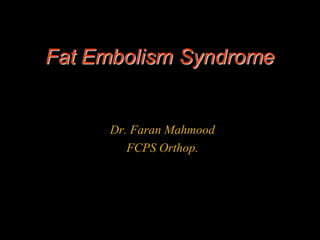
Fatembolism
- 1. Dr. Faran Mahmood FCPS Orthop.
- 2. First diagnosed in 1873 by Dr Von Bergmann Published in 1879 Fenger and Salisbury.
- 3. Fat Embolism: Traumatic fat embolism occurs in up to 90% of individuals with severe skeletal injuries, but < 10% of such patients have any clinical symptoms / signs Fat Embolism Syndrome: FE with clinical manifestation .
- 4. Incidence: 1-3% femur #, 5-10% if bilateral or multiple. Mortality: 5-15% Clinical diagnosis, No specific laboratory test is diagnostic Mostly associated with long bone/pelvic #s, and more frequent in closed fractures. Onset is 24-72 hours from initial insult
- 6. A high index of suspicion is needed for diagnosis is to be made. An asymptomatic latent period - 12-48 hours. The fulminant form presents as acute cor pulmonale, respiratory failure, - death within a few hours of injury.
- 7. Mechanical Theory Physical obstruction of the pulmonary & systemic vasculature with embolized fat. Temporary rise in I/M pressure - forces marrow into injured venous sinusoids. Cor pulmonale - inadequate compensatory pulmonary vasodilatation. Microvascular lodging - local ischemia and inflammation. Release of inflammatory mediators, platelet aggregation, & vasoactive amines.
- 8. The biochemical theory Circulating FFAs -directly toxic to Pneumocytes / capillary Endothelium in the lung - interstitial hemorrhage, edema & chemical pneumonitis. Coexisting shock, hypovolemia and sepsis - reduce liver flow exacerbate the toxic effects of FFAs.
- 9. H/E stain lung – - blood vessel with fibrinoid material and -optical empty space -lipid dissolved during the staining process.
- 10. TRAUMA
- 11. Hypoxemia Neurological Petechial abnormalities rash
- 12. Dyspnea, Tachypnea Hypoxemia PaO2 < 60 mm Hg
- 13. Clinically Tachpnea, Dyspnea, Hypoxia, rales, pleural friction rub & ARDS. High spiking temperatures. Hypoxemia - ventilation-perfusion mismatch & intrapulmonary shunting. Acute cor pulmonale -respiratory distress, hypoxemia, hypotension and elevated CVP. ½ of pts require mechanical ventilation CXR normal early on - later may show ‘snowstorm’ pattern- diffuse bilateral infiltrates CT chest: ground glass opacification with interlobular septal thickening
- 14. CNS signs usually occur after respiratory symptoms - nonspecific - features of diffuse encephalopathy Acute confusion, stupor, coma, rigidity, or convulsions - Transient and reversible in most cases CT Head: general edema – nonspecific MRI brain: Low density on T1 & High intensity T2 signal - correlates to degree of impairment
- 15. Reddish-brown non-palpable Petechial rash - upper anterior body, chest, neck, upper arm, axilla, shoulder, oral mucous membranes and conjunctivae in 20 - 50% patients. Pathognomonic, however, it appears late and disappears within hours. Results from occlusion of dermal capillaries by fat globules - extravasations of RBC
- 16. Retinopathy (exudates, cotton wool spots, hemorrhage) Lipiduria Fever DIC Myocardial depression (R heart strain) Thrombocytopenia Anemia, Decreased Hematocrit Hypocalcemia
- 17. Gurd’s criteria Most commonly used 1 major, plus 4 minor
- 19. Continuous pulse oximetry monitoring - at-risk patients ( those patients with long bone fractures) - detecting desaturations early. Consultations recommended include orthopedists, neurologists/ neurosurgeons, trauma care specialists, critical care specialists, pulmonologists, hematologists, and nutritionists.
- 20. The most effective prophylactic measure - operative reduction/rigid fixation of long bone fractures as soon as possible. Higher incidence (5 fold) when fixation delayed greater than 24 hours. Supportive care includes maintenance of adequate oxygenation and ventilation, stable hemodynamics, blood products as clinically indicated, hydration, prophylaxis of DVT and stress-related GI bleeding.
- 21. Albumin has been recommended - not only restores blood volume / binds fatty acids - may decrease the extent of lung injury. High dose corticosteroids have been effective in preventing development of FES in several trials, but controversy on this issue still persists.
- 22. Heparin has also been proposed as it activates lipase, but no evidence exists for its use in FES.
- 23. Difficult to predict –FES is frequently subclinical or overshadowed by other illnesses or injuries. Increased alveolar-to-arterial oxygen gradient and neurologic deficits, including coma, may last days or weeks.
- 24. As in ARDS, pulmonary sequelae usually resolve almost completely within 1 year. Residual subclinical diffusion capacity deficits may exist. Residual neurologic deficits may range from nonexistent to subtle personality changes to memory and cognitive dysfunction to long-term focal deficits.
- 25. Clinical diagnosis so high index of suspicion. Most effective management is prevention with rigid fixation of fractures within 24 hours When developed management is supportive.